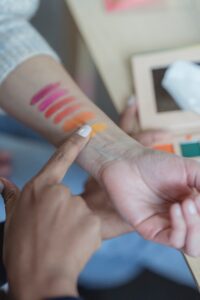How to Find the Right Colors for You

When it comes to beauty, one size does not fit all. What looks great on one person may not look as good on another. This is because our skin has different undertones, which can affect how colors look on us. Understanding your personal color palette can help you choose clothing, makeup, and hair colors that enhance your natural beauty and make you look your best. In this blog post, we’ll discuss how to find the right colors for you based on your skin’s undertones.
Identifying Your Skin’s Undertones
The first step in finding your personal color palette is to identify your skin’s undertones. Undertones are the subtle hues that exist beneath the surface of your skin. They can be warm, cool, or neutral.
To determine your skin’s undertones, start by looking at the veins on the inside of your wrist. If they appear blue or purple, you likely have cool undertones. If they appear green, you likely have warm undertones. If you can’t tell whether they appear blue or green, you may have neutral undertones.
Another way to determine your undertones is to hold up a piece of gold and a piece of silver jewelry against your skin. If the gold looks better, you likely have warm undertones. If the silver looks better, you likely have cool undertones. If both look good, you may have neutral undertones.
Choosing Colors Based on Your Undertones
Once you have identified your skin’s undertones, it’s time to start choosing colors that complement them. Here are some general guidelines for choosing colors based on your undertones:
Warm Undertones: If you have warm undertones, you’ll look best in warm colors, such as orange, yellow, peach, coral, and red. Earthy colors, such as olive green, mustard yellow, and brown, will also look great on you. Avoid colors that are too cool or icy, such as pastel blues or purples, as they can wash you out.
Cool Undertones: If you have cool undertones, you’ll look best in cool colors, such as blue, green, purple, and pink. Jewel tones, such as emerald green, sapphire blue, and amethyst purple, will also look great on you. Avoid colors that are too warm or orangey, as they can clash with your skin’s undertones.
Neutral Undertones: If you have neutral undertones, you’re lucky! You can wear a wide range of colors, both warm and cool. However, you may want to choose colors that are neither too warm nor too cool, such as beige, taupe, and gray, as they will complement your skin’s natural balance.
Tips for Choosing Colors Based on Your Personal Style and Preferences
Of course, your personal style and preferences also play a role in choosing colors that look good on you. Here are some tips for incorporating your personal style into your color choices:
- Think about the colors that make you feel happy and confident. If you love wearing bright, bold colors, don’t be afraid to incorporate them into your wardrobe, even if they don’t fit into your personal color palette perfectly.
- Experiment with different shades of the colors that suit you best. For example, if you have warm undertones and look great in peach, try experimenting with different shades of peach, such as coral or apricot.
- Consider the occasion. Some colors may be more appropriate for certain occasions than others. For example, a red dress may be perfect for a night out, but it may not be suitable for a job interview.
- Don’t forget about neutrals. Neutrals, such as black, white, and gray, can be the foundation of your wardrobe and can be paired with almost any color. They can also help balance out bolder colors.
Choosing Makeup and Hair Colors Based on Your Undertones
In addition to clothing, your personal color palette can also inform your makeup and hair color choices. Here are some tips for choosing natural makeup and hair colors based on your undertones:
- Foundation: When choosing a foundation, it’s important to find one that matches your skin’s undertones. If you have warm undertones, look for foundations with yellow or golden undertones. If you have cool undertones, look for foundations with pink or blue undertones.
- Blush: For a natural-looking blush, choose a shade that complements your skin’s undertones and natural beauty. If you have warm undertones, choose a peachy or coral blush. If you have cool undertones, choose a pink or rosy blush.
- Lipstick: When choosing a lipstick color, consider your undertones and your personal style. If you have warm undertones and love bold colors, try a bright orange or red. If you have cool undertones and prefer softer colors, try a pink or mauve.
- Hair Color: If you’re considering a new hair color, it’s important to choose one that complements your skin’s undertones. If you have warm undertones, try a golden blonde or auburn. If you have cool undertones, try a platinum blonde or ash brown.
In conclusion, understanding your personal color palette is essential when it comes to choosing clothing, makeup, and hair colors that enhance your natural beauty. By identifying your skin’s undertones and choosing colors that complement them, you can create a cohesive natural makeup and look that makes you look and feel your best. Don’t be afraid to experiment with different colors and shades to find the perfect combination for you.




